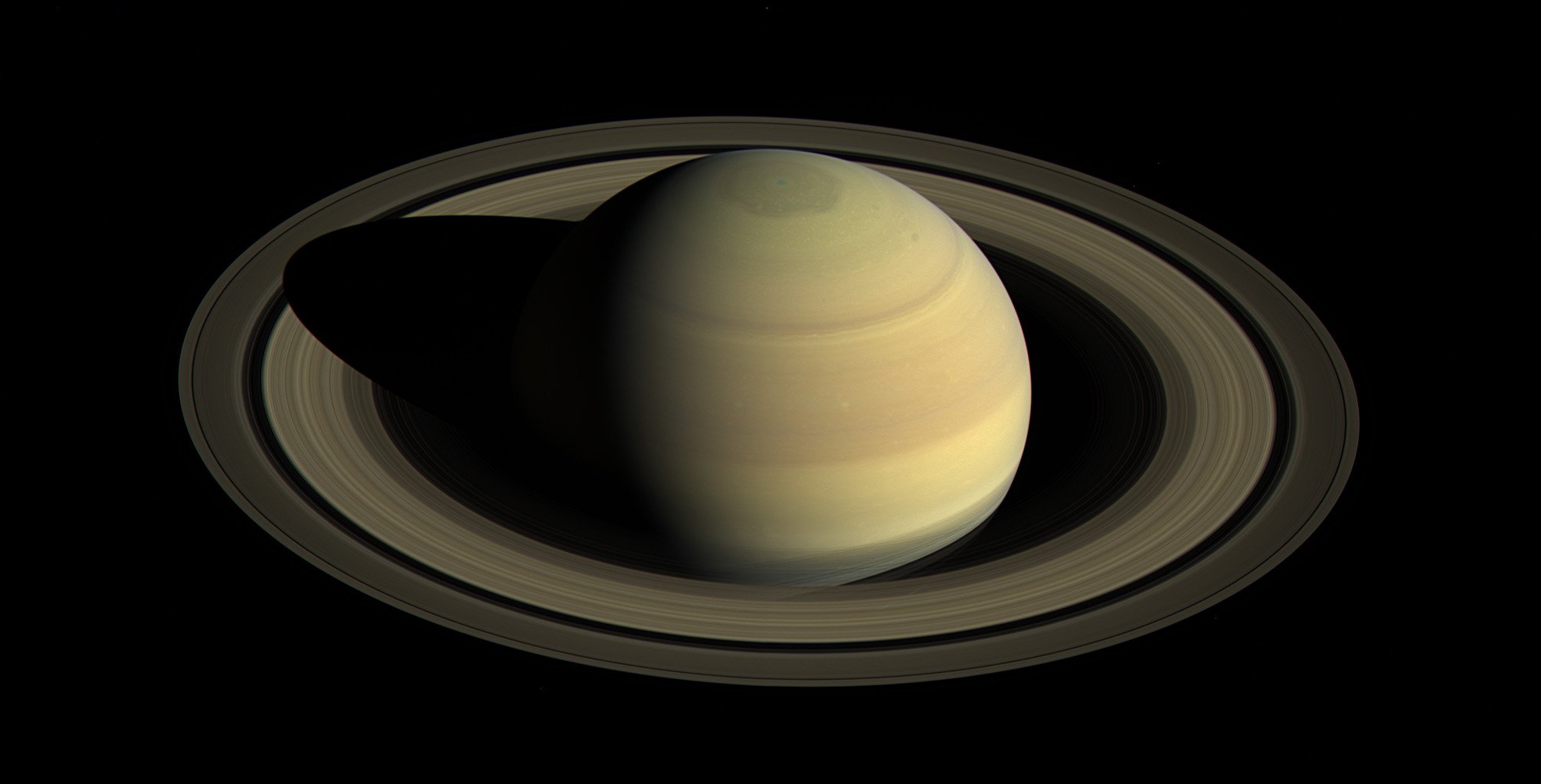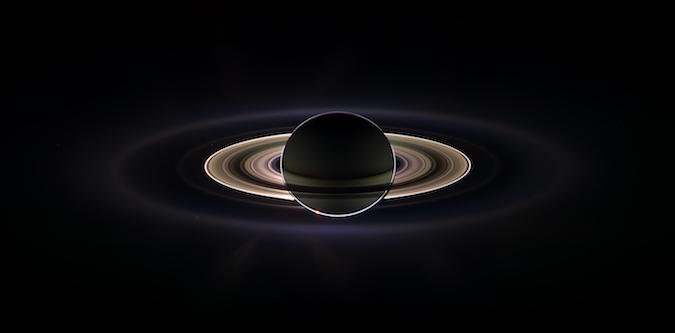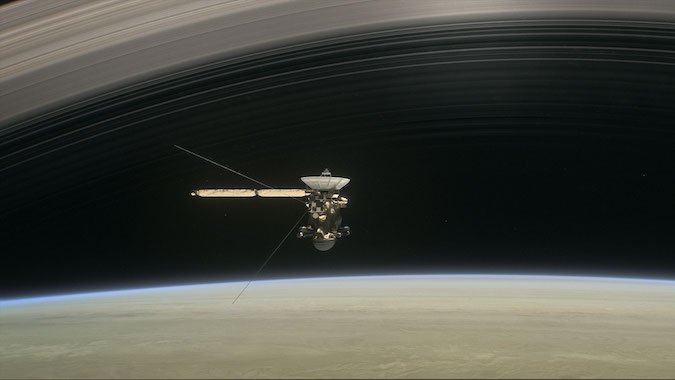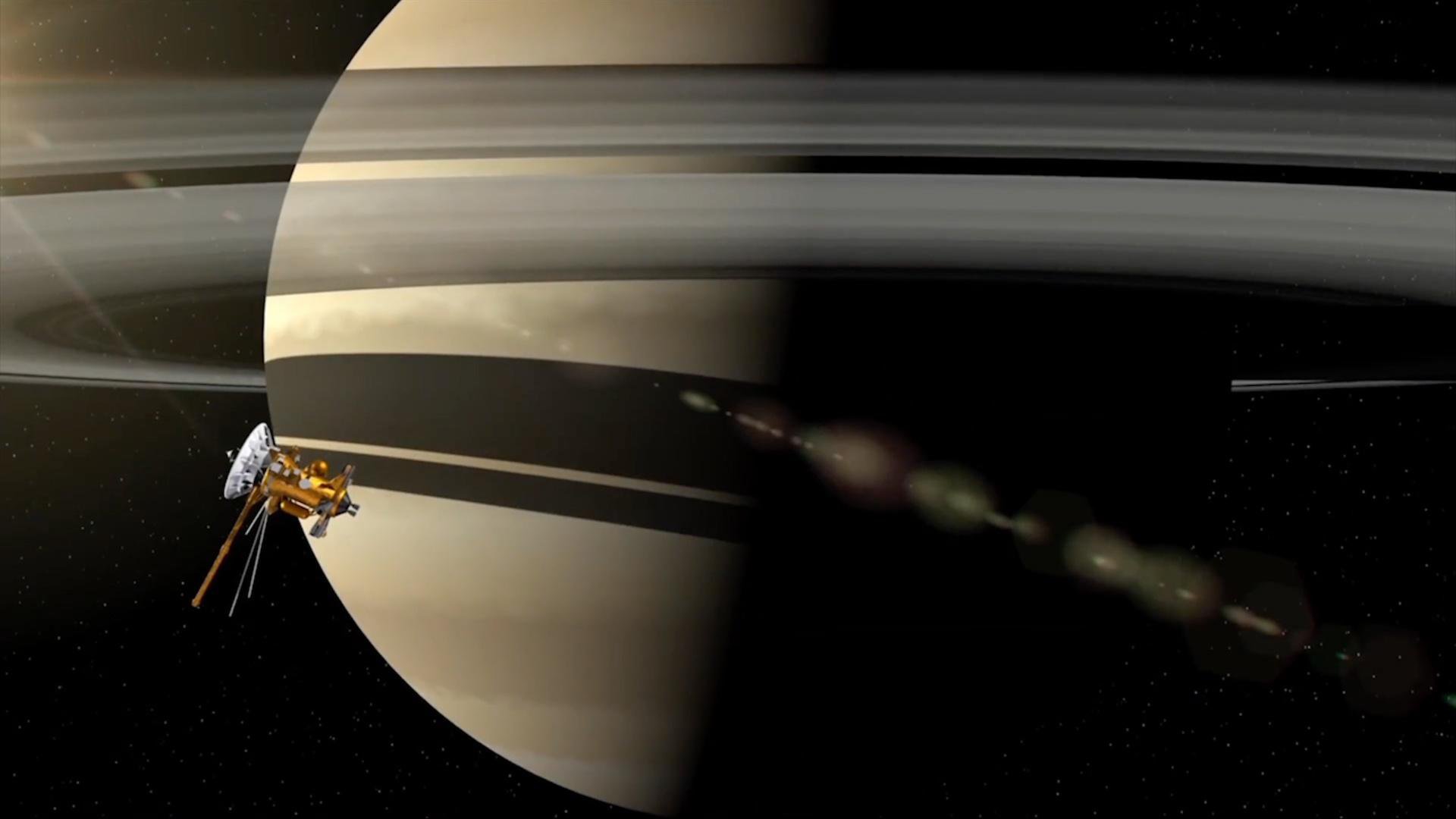Saturn’s Innermost Moons Are Red Ravioli, Thanks to Its Rings
The planet’s trademark rings appear to have played a crucial role in crafting the color and shape of some of its smallest moons.

Saturn's striking rings are probably its most recognizable feature—and they're not just for show. These rings seem to have shaped, and been shaped by, some of the planet's tiniest moons. Image Credit: NASA/JPL-Caltech/Space Science Institute
In the fall of 2016, Cassini was dipping into the dregs of its fuel stores.
By this point, the NASA spacecraft had already spent the better part of 12 years meandering through Saturn’s neck of the woods, stockpiling data on the ringed planet and its enigmatic moons. Less than a year later, in September of 2017, engineers would deliberately send the probe plunging down toward Saturn’s surface, ending its life in a fiery blaze.
But even in its terminal months, Cassini was gathering steam for a last hurrah.
During the final stages of its mission, Cassini executed a series of orbits that sent it weaving between Saturn and its main rings, drawing the spacecraft close enough to conduct flybys of five small ring moons—Pan, Daphnis, Atlas, Pandora, and Epimetheus—interlaced into the planet’s assemblage of icy girdles.
Now, the observations collected on these snaking sojourns, published today in the journal Science, paint a compelling portrait of how Saturn’s innermost moons might have come to be. A probable culprit? The planet’s own trademark rings, which likely had a role in shaping these moons from the start. For millions of years, Saturn’s moons and rings have been locked in an intimate, cataclysmic tête-à-tête of continual coevolution—one that’s still very much at work.
“This is a robust, evolving system,” says Matthew Tiscareno, a planetary scientist and Saturn ring expert at the SETI Institute who participated in the Cassini mission, but was not involved in the study. “These moons...might have grown up together with the rings.”
It wasn’t so long ago that these ideas were far from top of mind, however. The so-called “Five Fabulous Flybys” weren’t even in the mission’s original objectives. “We weren’t really supposed to be studying these moons,” says study author Bonnie Buratti, a planetary scientist at NASA’s Jet Propulsion Laboratory. “It was serendipitous—a golden apple that fell into our laps.”
But when the time came to direct the spacecraft inward, NASA scientists seized on the opportunity to get up close and personal with some of the planet’s innermost moons. “We realized it could be a brand-new mission,” says Linda Spilker, Cassini’s Project Scientist. “A chance to go where a spacecraft had never gone before. It was a no-brainer.”

Three of Saturn's small ring moons: Atlas, Daphnis, and Pan. Pan's equatorial band is much thinner and more sharply defined. The "core" of Atlas, beneath its fringe, is small relative to Pan's. Pan is about 18 miles in diameter and orbits 83,000 miles away from Saturn. Daphnis is only about 5 miles across and orbits 85,000 miles from Saturn. Atlas' diameter is about 19 miles and it orbits 86,000 miles from Saturn. Image Credit: NASA/JPL-Caltech/Space Science Institute
After all, Saturn’s moons, which number at least 62, are an irrefutably odd cast of characters. And many of the ones nearest to the planet’s surface are some of the strangest of all.
Two of the most inner moons, Pan and Daphnis, orbit in gaps within Saturn’s main set of rings, circling the planet like cosmic gutterballs. A set of others, including Atlas and Pandora, behave like nippy, militant sheepdogs, corralling the outer edges of Saturn’s A- and F-rings, respectively. Further out, Epimetheus engages another moon (Janus) in a bizarrely regular rendezvous, in which they exchange orbital positions every four years. Prior to Cassini’s approach, Pan, Daphnis, Atlas, Pandora, and Epimetheus had never been studied up close. But thanks to measurements taken by six of Cassini’s 12 instruments, these five mysterious moons have finally begun to come into focus.
This isn’t the first time these eccentric little satellites have taken center stage. The first images Cassini beamed back of Pan and Atlas, two of Saturn’s innermost moons, showed that both boast prominent equatorial ridges, or rocky bulges at their midsections that give the moons perplexingly pot-bellied shapes.
At first, many were flummoxed. “None of us expected to find these tiny ravioli moons at Saturn,” says Richard French, a planetary scientist at Wellesley College who was involved in the Cassini mission, but did not contribute to the study.
In the years since, Pan and Atlas have also been compared to UFOs, dumplings, and empanadas. But Buratti is partial to the image of ballerinas in tutus. And the new findings suggest that these moons are probably just as dynamic as their dancing namesakes.
Based on Cassini’s measurements, Buratti and her colleagues discovered that the flared skirts of Atlas and Pan (and perhaps Daphnis, which wears a very subtle belt) were smoother and more pristine than the cores they adorned. They also appeared to be made up of a loose, low-density material. This indicates that the moons weren’t born with these fringes, and could have formed in multiple stages, Buratti says.
That doubled the number of genesis events the researchers had to explain: one for the body, and one for the bulge. They still aren’t sure exactly how the ring moons got their start. One possibility is that they were born out of a larger planetary body that broke apart, seeding shrapnel in Saturn’s rings; another is that they formed from an agglomeration of particles entirely within the ring system itself.
Whatever the case, it’s likely that Pan, Daphnis, and Atlas were once simple, naked spheres. But as these moons pirouetted through their parent planet’s rings, whirling and twirling through a haze of ice and rock, they slurped up the slurry of particles jostled out of place. Due to the thinness of the rings, dust glommed primarily onto the moons’ equators, giving them their pot-bellied physique.
Even today, moons like these might still be expanding their waistlines. Beyond a certain point, however, passing particles might have a hard time sticking due to the pull from Saturn’s gravity, Spilker says. “The skirts can only get so big,” she says.

Saturn's moon, Pandora, which is roughly 52 miles in diameter. It orbits 88,000 miles away from Saturn. Image Credit: NASA/JPL-Caltech/Space Science Institute
Costume changes aside, the proximity between ring and moon might explain another striking find from Cassini’s cameras: Moons orbiting deep within the ring system are more likely to have a rouge-red hue—one that bears an uncanny resemblance to the crimson particles that speckle Saturn’s rings. Such is the case with Pan, the innermost and ruddiest moon, followed closely by the slightly less rosy Daphnis and Atlas.
It’s not yet clear what exactly gives the ring material its blush (theories include iron or a combination of organic molecules). Whatever they are, these inscrutable scarlet sparkles don’t seem to travel well. The further out from Saturn a moon orbits, the less likely it is to be red. Instead, more distant moons like Epimetheus are blue—likely due to a frigid spray of azure particles and vapors erupting off the geologically active moon Enceladus.
These icy plumes jet far inward—but tight-orbiting moons like Pan appear to be protected from Enceladus’ paintbrush by the same rings that stain them red. And with pigments encroaching in from both directions, Saturn’s inner moons manifest in a dazzling gradient of cosmic color.

Saturn's moon Epimetheus, which is about 72 miles in diameter, and orbits about 94,000 miles away from the planet. Image Credit: NASA / JPL / Cassini-ISS / Justin Cowart
It’s clear that Saturn’s inner moons are shaped by their surroundings. But these small satellites aren’t just passive passengers. As they orbit, moons can push and pull rings, sculpting and massaging them into new configurations. Some like Pan even blaze their own trails as they orbit, maintaining the gaps in which they reside like intrepid little vacuums. Moons can also be influential from afar, as when the icy plumes jetting off Enceladus feed into one of Saturn’s outermost rings. In Saturn’s neighborhood, rings and moons engage in a perpetual tango—and the choreography is always changing.
“This definitely points to the fact that rings and moons in this system are absolutely not independent,” says Sarah Dodson-Robinson, a planetary scientist at the University of Delaware who was not involved in the study. “They exert a lot of control over each other.”
These processes are only a fraction of the forces still at work today, Buratti says. Recent work hints that the planet’s rings (and perhaps, by extension, its ring moons) might actually be quite young—relatively speaking, that is, at 100 or 200 million years old. But on the timescale of a 4.5-billion-year-old planet, that makes Saturn’s most recognizable accessories fairly late additions to its wardrobe. And the rings’ tenure might be brief: In another hundred million years, they could be gone entirely.
“This really shows that there is no substitute for going and looking,” French says. “We speculated about what we thought Saturn’s rings would be like, but every mission has revealed them to be more interesting and complex than we thought before.”
With so much going on, the Saturn of today might be unrecognizable a few million years into the future. After all, in active planetary systems, the only constant is change.
“In our old view of the Solar System, we thought, ‘Everything has been like this forever,’” Buratti says. “But it’s actually an ongoing process of violence. There are impacts, things rearranging themselves. It’s one giant, dynamic system.”




